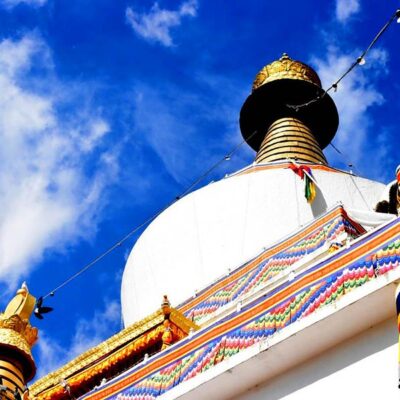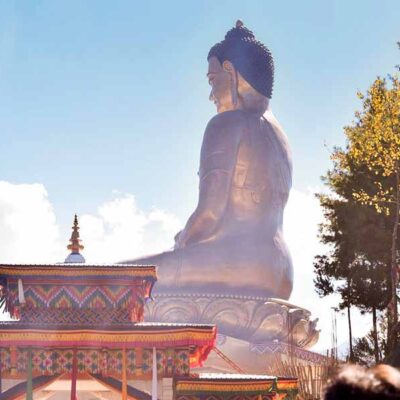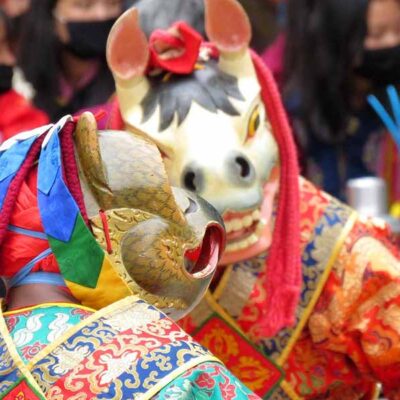The Best of Bhutan
12 days
This 12-day itinerary is designed to immerse travelers in the sacred and cultural heart of Bhutan—Druk Yul, the Land of the Thunder Dragon. It traces a spiritual journey through the most revered sites blessed by Guru Rinpoche (Padmasambhava) during his travels from India to Tibet in the 8th century CE, while also offering a deep encounter with the rich traditions, untouched nature, and daily life of this Himalayan kingdom.
Bhutan stands apart from its neighbors in the Eastern Himalayas. Here, all elements of nature are considered sacred: mountains, forests, rivers, and even the animals that inhabit them. As a result, Bhutan has become a refuge for endangered species and a global model for environmental preservation. This spiritual ecology is inseparable from its identity as the last stronghold of Vajrayana Buddhism, one of the most profound schools of Buddhist thought and practice.
The journey begins in Thimphu, where you will explore traditional arts, sacred monasteries, and the principles of Gross National Happiness. You will then follow the path of the great masters to Dodeydra Monastery, to experience the rhythms of monastic life. In the sacred valleys of Phobjikha, Trongsa, and Bumthang, you will walk through highland meadows, chant with monks, visit ancient dzongs, and hike to holy cliffside temples like Shugdrak, believed to embody the presence of Guru Rinpoche himself. Here you will have the chance to attend a meditation session with Tantric monks residing in the area.
The valley of Punakha opens a window onto Bhutanese rural life, where you will share in daily agricultural rituals, witness traditional archery, and stroll through village landscapes with views over the majestic Punakha Dzong. The journey concludes in Paro, with the unforgettable pilgrimage to Taktsang Monastery (Tiger’s Nest)—a sacred site miraculously blessed by Guru Rinpoche, who arrived on the back of a flying tigress to subdue local spirits and spread the Dharma.
Throughout the program, you will hike peaceful forest trails, visit remote temples steeped in legend, bathe in healing hot stone baths, and engage with the living heritage of Bhutanese spirituality. More than just a travel experience, this itinerary offers a path to reconnect—with nature, tradition, and your inner stillness—by following in the footsteps of saints, sages, and seekers who have journeyed here for centuries.
JOURNEY OVERVIEW AND PROGRAM DETAILS
DAY 1: ARRIVAL IN PARO
Paro – Thimphu
Transfer to the airport for your flight to Paro. Your discovery of the enchanting Kingdom of Bhutan begins with a flight over the Himalayas into the lush green valley of Paro—truly one of the most spectacular sights in the world. During the flight, you will admire some of the highest and most majestic peaks on earth and enjoy the approach to the valley, with its ancient alpine forests, monasteries, temples, and farmhouses nestled in magnificent mountain solitude.
Upon arrival in Paro, you will be welcomed by our local representative and transferred to Thimphu, the capital. The beautiful drive from Paro to Thimphu takes about one hour, following the Paro River to its confluence, then continuing along the Thimphu River valley to the city.
After checking into the hotel, you will visit the tallest seated Buddha statue, the Memorial Chorten, and the enclosure of the Takin, Bhutan’s national animal.
Later, visit the Choki Traditional Art School (CTAS), located just north of Thimphu, in the scenic mountain valley of Kabesa. Founded in 1999, the school provides training for underprivileged youth in traditional Bhutanese arts such as drawing, thangka painting, weaving, embroidery, sculpture, and wood carving. The students live, study, and develop skills for their future within the school complex, which consists of whitewashed traditional Bhutanese buildings on the sunny slopes of a hill, surrounded by farms and villages. Currently, the school hosts 136 students between the ages of 15 and 25, most of whom attend for six years. Here you will have the opportunity to interact with the students and learn one of the artistic techniques.
In the late afternoon, you will have the chance to engage in a discussion on Gross National Happiness (GNH) with local experts.
Overnight in Thimphu (D/B/L)
DAY 2: HIKE TO CHERI AND TANGO MONASTRIES
Thimphu
After breakfast you will hike to Cheri Goemba monastery Drive 30 minutes to Dodena and hike about 45 minutes through beautiful forest trails to Cheri Monastery built in 1620. Cheri Monastery Hike gives you an insight into the natural discovery of Himalayan vegetation. The hiking trail passes through the off-beaten forest where one often gets to spot a variety of birdlife. The hike to this very scenic monastery is steep but relatively short, with several sacred sites scattered throughout the lush forest. Along the way there is a good chance of encountering wild animals (monkeys, deer…). Cheri monastery is one of the main retreat centres and a popular pilgrimage site in the country. Cheri Gompa was founded by Ngawang Namgyal, the Rinpoche who unified Bhutan as one political and spiritual entity. Its main function is as a retreat centre for the Drukpa Kagyu school of Vajrayana Buddhism. You can see a beautiful painting of Guru on the solid rock. Picnic lunch will be served near the river bank near wooden bridge. After lunch we will continue our hiking to Tango Monastry. Tango literally means the ‘horse head’. The legend goes back to the 13th century when Lam Phajo Drugom saw the cliffs, hills, and rocks manifesting into the form of the mandala of Yidam Deity Tandin (Hayagriva); the horse-headed deity. The place holds rich recorded history down to the Drukpa lineage Zhabdru. Enjoy walking on the stone-paved path into the deep wilderness of rhododendron and oak vegetation. In the late afternroon return back to Thimpu for dinner and rest for the overnight.
Overnight in Thimpu (B/L/D)
DAY 3: LIVING A DAY IN A MONASTRY
Thimphu – Monastero di Dodeydra
After breakfast transfer towards hike to Dodeydra monastery. If you love nature, tranquillity, butterflies and the off beaten track then Dodeydra hike has a lot to offer. This beautiful and easy hike takes you to a hidden land, providing a hiker a sense of awe and wonder and a point of self-reflection along the way. The name Dodeydra has been derived from the split rock from where the Ter (Hidden Treasure) in the form of scripture was discovered. The monastery is beautifully built between the split rock and it has two altars and beautiful paintings on the wall. The monastery also houses a small museum with many historic and religious artifacts and stories attributed to one of the Chief Abbot Jamyang Gyeltshen, considered an acclaimed craftsman who made numerous statues and paintings/murals. There are around 175 monks living here so today you will have a chance to learn how Buddhism is practiced in Bhutan. In the afternoon you will attend a meditation session on Samtha or vipassana. At 6,30 pm you can join the monks for the evening prayer.
Overnight in the Monastery guest house or in a camp site (B/L/D).
DAY 4: TRANSFER TO PUNAKHA
Dodeydra – Punakha
After breakfast, depart from the Dodeydra Monastery and begin the scenic drive towards Punakha (approx. 2.5h). The road winds through forested valleys and ascends to the stunning Dochula Pass (3,140 m), where 108 chortens crown the hilltop. Here, you can enjoy a warm tea or coffee break while taking in breathtaking views of the snow-clad Himalayan range. If the sky is clear, the immense peaks of the eastern Himalayas reveal themselves, creating a picture-perfect panorama.
After descending from the pass on a well-maintained asphalt road, stop for a traditional lunch at a local restaurant. In the afternoon, take a leisurely walk through rice fields to visit Chimi Lhakhang, also known as the Temple of Fertility. Built by the “Divine Madman” Drukpa Kunley, this small yet revered temple is surrounded by fields and adorned with playful murals and symbols of fertility. It remains a place of pilgrimage for couples hoping to conceive.
Continue with a visit to the grand Punakha Dzong, built between 1637 and 1638 at the confluence of the Pho Chhu and Mo Chhu rivers. One of the most magnificent and historically significant dzongs in the country, it showcases classic Bhutanese architecture and plays an important role in religious and political life.
Overnight in Punakha (B/L/D)
DAY 5: LOCAL FARM EXPERIENCE IN PUNAKHA
Punakha
After breakfast, begin your exploration of Punakha Valley’s rural culture and traditions. You’ll drive to Nubgang village, where you can actively participate in typical farm activities such as darts, archery, and seasonal agricultural work.
You will also have the opportunity to observe a Bhutanese cooking demonstration during the preparation of your lunch.
In the afternoon, take a scenic walk downhill through nearby villages. This is a chance to closely observe local farming practices and rural life, while also enjoying a spectacular view of Punakha Dzong in the distance.
Later in the day, you may choose to relax with a traditional hot stone bath (optional).
Overnight in Punakha (B/L/D)
DAY 6: TRANSFER TO PHOBJIKHA VALLEY
Punakha ⎯ Phobjikha
After breakfast, depart from Punakha and begin the scenic drive towards the glacial valley of Phobjikha (approx. 4.5 hours). The journey ascends again through the spectacular Dochula Pass at 3,140 meters. Stop here to stretch your legs, admire the 108 chortens, and—weather permitting—enjoy panoramic views of the eastern Himalayan range.
On arrival in Phobjikha, check in and enjoy a traditional Bhutanese lunch. In the afternoon, begin the Phobjikha Nature Hike, which starts just below Gangtey Gompa near the Mani wall chorten. The trail leads through pine forests and open meadows, passing by Khewa village and its ancient 14th-century Khewa Lhakhang, inviting moments of reflection in the serene landscape.
Next, visit the Crane Information Centre, where you’ll learn about the conservation efforts for the endangered black-necked cranes, which winter in this valley from Tibet.
At 6:30 PM, join the monks at Gangtey Monastery for the peaceful evening prayer session (6:30–7:30 PM), surrounded by the quiet spirituality of one of Bhutan’s most important Nyingma institutions.
Overnight in Phobjikha (B/L/D)
DAY 7: DRIVE TO TRONGSA
Phobjikha – Trongsa
At dawn, the day begins in a spirit of renewal. You will have the opportunity to participate in the ancient Thrusel ritual—an aromatic fumigation ceremony held at the Shedra (monastic school), performed by monks to cleanse negative energies and invite auspiciousness for the journey ahead. As fragrant juniper smoke rises into the crisp valley air, prayers are chanted softly, carrying blessings into the mountains.
After breakfast, depart from the serene Phobjikha Valley and begin your journey toward Trongsa. The scenic drive takes approximately 4 hours and crosses the Black Mountains, offering panoramic views of lush vegetation, remote hamlets, and the untouched wilderness of central Bhutan.
Along the way, pause at Chendebji Chorten, a serene Nepalese-style stupa nestled beside a river, and continue past Rukubji village, known for its slate-roofed stone houses and terraced fields that shimmer in the light.
Upon arrival in Trongsa, check in at your hotel and take time to rest. In the late afternoon, visit the majestic Trongsa Dzong, the ancestral seat of Bhutan’s royal family and one of the most strategically located fortresses in the country. Time permitting, continue to the Royal Heritage Museum, housed in the old watchtower above the valley—where relics, paintings, and royal heirlooms quietly narrate Bhutan’s spiritual and political legacy.
Overnight in Trongsa. (B/L/D)
DAY 8: BUMTHANG VALLEY
Trongsa – Valle di Bumthang
After breakfast, depart for the sacred Bumthang Valley (approx. 3h), the spiritual epicenter of Bhutan, where legends, saints, and silence converge. The road unfolds through pine forests and peaceful ridges, drawing you deeper into a landscape that seems suspended between earth and sky.
Upon arrival, begin your exploration at Jakar Dzong, a 16th-century fortress perched like a guardian above the Chokhor Valley, offering sweeping views and sheltering a monastic school within its quiet courtyards.
Continue to Jambay Lhakhang, one of Bhutan’s oldest temples, built in 659 A.D. by Tibetan King Songtsen Gampo. Its timeless walls echo with centuries of devotion and pilgrimage.
Then, visit Chakhar Lhakhang, the modest yet storied temple built upon the foundations of the legendary iron palace of King Sindhu Raja—its relics and oral histories connecting past and myth.
As evening nears, enjoy a gentle walk around Wangdicholing Palace, Bhutan’s first royal residence, now quiet and contemplative. Stroll through surrounding villages and Bumthang town, where daily life flows with ancestral calm.
Overnight in Bumthang. (B/L/D)
DAY 9: SACRED CLIFFS & RURAL TRADITIONS
Bumthang
Before the sun climbs high, begin your morning hike to Shugdrak, one of Bhutan’s four sacred cliffs, wrapped in pine-scented air and early mist. Tucked into the rock face, this revered shrine dedicated to Guru Rinpoche invites pilgrims to meditate and pray where the mountain breathes peace. Upon arrival, take part in a quiet moment of prayer with the resident monks—an intimate ritual of incense, chant, and sacred space. The journey, passing Thangbi village, a Mani wall, and prayer wheels, is as much inner as outer.
Return to the lodge for lunch and rest. In the afternoon, continue your spiritual path with visits to Kurjey Lhakhang, where Guru Rinpoche meditated in the 8th century and left his body imprint upon a sacred rock—a site of deep pilgrimage and renewal. The temple complex nestles between cliff and forest, echoing mantras and the rustle of cypress trees.
End the day at Tamshing Lhakhang, founded in the 14th century by Pema Lingpa, Bhutan’s great tertön. Within its ancient walls, faded murals and an iron chain worn by penitents speak softly of karmic cleansing and faith lived through centuries.
Overnight in Bumthang. (B/L/D)
DAY 10: FLIGHT TO PARO – VISIT PARO
Bumthang – Paro
After breakfast, transfer to the airport for your domestic flight from Bumthang to Paro. As the plane rises above the emerald valleys and cloud-kissed peaks, Bhutan reveals itself in all its vertical majesty—a sacred scroll of forest and stone unrolling beneath your feet.
Upon arrival in Paro, transfer to your hotel and settle in before beginning the final chapter of your journey.
Your afternoon opens with a visit to Kyichu Lhakhang, one of the 108 temples said to have been built in a single night by Tibetan King Songtsen Gampo. This 7th-century sanctuary is a living testament to Bhutan’s spiritual roots—its prayer wheels spinning timeless mantras, its orange trees blooming with unexpected grace.
Continue to Paro Dzong, a masterpiece of 17th-century architecture rising above the valley floor like a guardian. Cross the wooden cantilever bridge and step into the cool silence of stone corridors where monks chant and incense curls toward painted beams. The Utse, or central tower, commands reverence with its delicate murals and sacred relics.
After returning to town, enjoy a stroll through Paro’s main street, where traditional wooden facades hide cafés, textile shops, and quiet courtyards. You may choose to conclude your day with a rejuvenating session at the Jiva Spa (optional), drawing on Bhutanese herbal wisdom and age-old therapies to ease body and mind before your final ascent to the Tiger’s Nest.
Overnight in Paro. (B/L/D)
DAY 11: HIKE TO TIGER NEST MONASTERY
Paro
Wake early to enjoy a breathtaking sunrise from your high-altitude campsite. After breakfast, begin your descent through peaceful rhododendron and pine forests, following a quiet trail that leads directly to the upper temples of Taktsang Monastery. This exclusive approach allows you to visit the sacred Zangdopelri Temple, with a unique bird’s-eye view of the main monastery below, dramatically clinging to the cliffside. After a moment of reflection and a butter lamp offering, continue down to explore the main sanctuaries of Bhutan’s most iconic spiritual site. At the base, your driver will take you back to Paro. Later visit a farmhouse where you will be able to see various Bhutanese traditional way of making rice wine, the Zaw, the Suja making (butter tea), learn traditional game of Archery and Degor (play with stone). Evening Enjoy a traditional hot stone bath. Back to hotel for a well-earned rest.
Overnight in Paro (B/L/D)
DAY 12: DEPART FROM PARO
Paro
Say goodbye to Bhutan and board a flight for onward destinations. We hope you’ll carry this gentle kingdom in your heart: May it brings peace to you and others. Have a safe journey.
ACTIVITIES
- Admire Mount Chomolhari during your arrival flight into Paro and from Dochula Pass.
- Visit the Choki Traditional Arts School and engage with local students practicing traditional crafts.
- Hike to Cheri Monastery through forest trails rich in Himalayan flora and birdlife.
- Continue hiking to Tango Monastery, nestled among rhododendron and oak forests.
- Spend a full day at Dodeydra Monastery, joining meditation and evening prayers with resident monks.
- Cross the Dochula Pass (3,100 m) and marvel at the 108 chortens with panoramic views of the Himalayas.
- Enjoy the Phobjikha Nature Hike, walking through pine forests, open meadows, and rural villages.
- Attend the evening prayer session at Gangtey Monastery, a key Nyingma institution in the glacial valley.
- Visit Trongsa Dzong, the ancestral seat of Bhutan’s royal family.
- Explore the Royal Heritage Museum, located in the historic watchtower above the valley.
- Discover the sacred temples of the Bumthang Valley: Jakar Dzong, Jambay Lhakhang, Chakhar Lhakhang, Kurjey Lhakhang, and Tamshing Lhakhang.
- Hike to Shugdrak Temple, one of Bhutan’s four sacred cliff shrines, with sweeping views of the valley.
- Observe a traditional Bhutanese cooking demonstration and enjoy a farm-style lunch in Punakha.
- Walk through Punakha’s agricultural villages, observing rural life and scenic views of Punakha Dzong.
- Stroll through rice paddies to reach Chimi Lhakhang, the famous Temple of Fertility.
- Visit a traditional farmhouse in Paro and learn how to make rice wine (ara), butter tea (suja), and puffed rice (zaw).
- Try your hand at archery and Degor, Bhutan’s traditional stone-throwing game.
- Rejuvenate with two traditional hot stone baths, one in Punakha and another in Paro.
- Visit Rinpung Dzong and cross the traditional wooden cantilever bridge in Paro.
- Hike to the Tiger’s Nest Monastery (Taktsang) via a secluded upper trail with access to Zangdopelri temple.
SOCIAL AND ENVIRONMENTAL IMPACT
This itinerary has been carefully crafted to foster direct and indirect benefits for local communities, the natural environment, and Bhutanese cultural heritage. Wherever possible, we have chosen traditional accommodations and locally owned establishments that demonstrate a commitment to sustainability, following the principles of responsible tourism.
The tour promotes community-based experiences, supporting local economies through collaboration with homestays, village visits, and artisan workshops. Bhutan, home to a rich mosaic of indigenous cultures, ethnic groups, and dialects, remains a unique destination where tradition and nature are deeply intertwined. Some of the villages visited during this itinerary have only recently opened to tourism and remain committed to preserving their environment and customs. Visitors’ presence supports community schools, libraries, and wildlife conservation efforts—key elements of Bhutan’s development philosophy known as Gross National Happiness (GNH).
In Thimphu, our visit to the Choki Traditional Art School (CTAS) helps preserve Bhutan’s artistic heritage while empowering underprivileged youth through skill-based education. CTAS is the only private institute offering training in the traditional 13 Bhutanese arts (Zorig Chusum) at no cost to students, and your presence contributes to sustaining this mission.
Participants also explore initiatives like the Voluntary Artists’ Studio (VAST), which provides vocational and creative opportunities for Bhutanese youth through social art programs. Another meaningful stop includes the Bhutan Youth Development Fund’s “Simply Bhutan” Village, a dynamic project nurturing leadership, teamwork, and social awareness among youth while sharing traditional lifestyles with visitors.
Every moment of this journey has been designed to deepen your understanding of Bhutan’s spiritual, ecological, and cultural landscapes, while positively impacting the communities you encounter.
TIPS BEFORE DEPARTURE
Traveling to Bhutan requires a mindful and respectful spirit. This journey invites you to explore deeply—with humility, curiosity, and adaptability. Let go of preconceptions and open yourself to new ways of seeing and being.
In return, Bhutan will reward you with profound encounters—from quiet monastery rituals to the serenity of sacred landscapes—leaving lasting impressions and inner clarity.
Before you leave, prepare for varied altitudes and temperatures. Bring clothing suited for layering, including warm sweaters and rain protection, especially if you’re traveling between October and April. Comfortable walking shoes are essential, and a hat, sunglasses, and flashlight will prove useful. Don’t forget a small kit with personal medications and basic first aid supplies.
Bhutanese customs place great importance on respect and modesty. When visiting monasteries and temples, dress with decorum—shoulders and legs covered—and always remove your shoes before entering sacred spaces.
Some days on this journey involve moderate hiking and high altitudes (up to 3,400 meters), so good general fitness is important. Consult your doctor ahead of time, especially if you have any health concerns.
Finally, know that travel in Bhutan is regulated. A certified local guide will accompany you throughout the trip. If you plan to travel during festival periods, early booking is essential, as accommodations and permits are limited.
This journey is more than a tour—it’s a shared path through culture, nature, and spirit, enriching both you and the people you’ll meet.
HOTELS
HOTEL CATEGORIES: 3-STAR SUPERIOR
In Bhutan, we have selected mid category hotels with all the major facilities and comforts but in the true tradition of Bhutanese hospitality.
TRANSPORT
We will be using comfortable and air-conditioned mini-coach/van throughout the entire trip.
WHEN TO GO
It is possible to visit Bhutan all year around but the best weather is generally:
Mar–May (spring)/ MidSep–MidNov (autumn). Spring (March April & May) is the most beautiful time of the year, resplendent and ablaze with a spectacular array of bright colours. Also, it is the time to witness the famous Paro tsechu festival. The Paro Tshechu is held every spring and is one of the most colourful and significant events in Paro Dzongkhag (district). Autumn (September, October & November) is lovely with clear and crisp blue skies, providing a grand view of some of the tallest unclimbed mountains in the world. It is the best time for trekking and for travelling. This is instead the right time to assist to the Thimphu tsechu festival!




